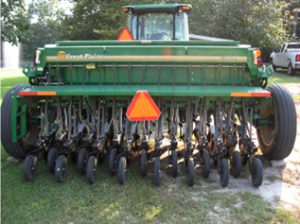It is the time of year to start implementing cool-season forages in your pastures. Our perennial warm season pasture grasses in Florida become dormant in the fall and winter months because of the shorter days, cooler temperatures, and frosts. Planting a cool-season forage provides many benefits to your herd. These grasses are usually higher in total digestible nutrients (TDN) and crude protein (CP) than our summer grasses or hay. Being strategic when planting and growing these forage crops is essential to the success of the establishment and success of your cool-season forage pastures. The type of soil and the amount of rainfall will determine which cool season forages you want to plant. Below are the steps to consider when planting your cool-season forages in your pasture:
 Cattle grazing ryegrass in February (Photo Credit: Lizzie Whitehead).
Cattle grazing ryegrass in February (Photo Credit: Lizzie Whitehead).
Recommended Steps to Planting Cool-Season Forages:
Decide which type of cool-season forages to plant.
Pick which cultivar and varieties you want to plant. Many improved varieties have been developed by the UF/IFAS Forage Breeding team.
Take soil samples in your designated area.
Before planting, take soil samples in the area where you want to plant cool-season forages and bring your sample to your local extension office. Cool season forages typically require a fine adjustment of soil pH and nutrient levels than your traditional Bahia or Bermuda grasses.
Prior to planting, prepare your seedbed.
Options might include mowing, light disking, moldboard plow, heavy-disk harrow, rototiller, or many other cultivating tools to prepare the seedbed. Level the area before planting. Overseeding (planting over the existing pasture) is an option but requires special equipment like a no till drill. You can broadcast over sod with ryegrasses and clovers. When planting over your established pasture, it is important to wait until after the first frost.
Calibrate your equipment based on which cultivar you chose.
Calibrate your planter every year. Make sure soil moisture conditions and weather forecasts are ideal. If the soil is too dry and there is no forecast of rain, seeds will not germinate.

No-till drill planter. Photo by: Dennis Handcock, University of Tennessee
Base your fertilizer output off the UF/IFAS Soil Lab recommendations.
Application of a starter fertilizer can be applied at planting (P and K plus 30 pounds of nitrogen), right after germination. A follow-up application of nitrogen 45-60 days after planting would also be beneficial for the grasses and give them nutrients to produce a higher yield.
Keep livestock out of your newly planted cool-season pasture.
It is recommended to fence off this newly planted cool-season pasture, so your livestock do not graze it too early when it is fragile and not well established. Let the cool-season forage grow to optimal height depending on which cultivar you choose.
If you have any questions related to cool-season forages or winter grazing strategies for your livestock, contact your local UF/IFAS Extension Agent. For further information regarding cool-season forage variety, check out this UF IFAS EDIS publication SS-AGR-84: https://edis.ifas.ufl.edu/publication/AA266.
Source: UF/IFAS Pest Alert
Note: All images and contents are the property of UF/IFAS.



